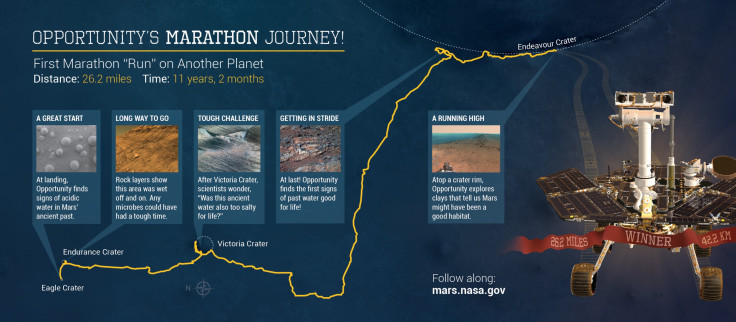NASA's Opportunity Rover Completes Marathon On Mars In Just Over 11 Years

Not content with exceeding its designated lifespan of three months by over a decade, NASA’s ageing Opportunity rover has set yet another record. The rover has now become the only man-made object to complete a marathon -- a distance of just over 26 miles -- on the surface of another celestial body.
The rover, which has been on the Martian surface since January 2004, completed a distance of 26.2 miles in 11 years and 2 months (or 3,968 Martian days), according to a statement released by NASA on Tuesday. The latest record comes less than a year after Opportunity surpassed the 24-mile distance covered by Soviet Union’s Lunokhod 2 rover on the moon in 1973.
“This mission isn't about setting distance records, of course; it's about making scientific discoveries on Mars and inspiring future explorers to achieve even more,” Steve Squyres, Opportunity principal investigator at Cornell University in Ithaca, New York, said in the statement. “Still, running a marathon on Mars feels pretty cool.”

During its 26-mile journey, Opportunity has found a plethora of evidence that the red planet was once a much more habitable place and that it might even have harbored microbial life.
However, a decade of trudging on the Martian surface has taken its toll on the rover. In December last year, NASA reported that Opportunity was having bouts of “amnesia” and that its flash, or non-volatile, memory was facing issues. After avoiding the use of the flash memory for three months, NASA successfully reformatted its memory banks earlier this week, enabling the rover to collect more data daily and carry out much more complicated experiments and observations.
“Opportunity can work productively without use of flash memory, as we have shown for the past three months, but with flash we have more flexibility for operations … the flash memory allows data from intensive science activities to be returned over several days,” John Callas, Opportunity project manager at NASA's Jet Propulsion Laboratory in Pasadena, California, said in a statement.
However, no matter how glorious its mission has been, NASA has made it clear that the rover’s days are numbered. The space agency’s proposed budget for 2016 does not earmark any money for its support, and instead focuses on the Mars 2020 mission and a robotic probe to Jupiter’s moon Europa.
© Copyright IBTimes 2024. All rights reserved.












